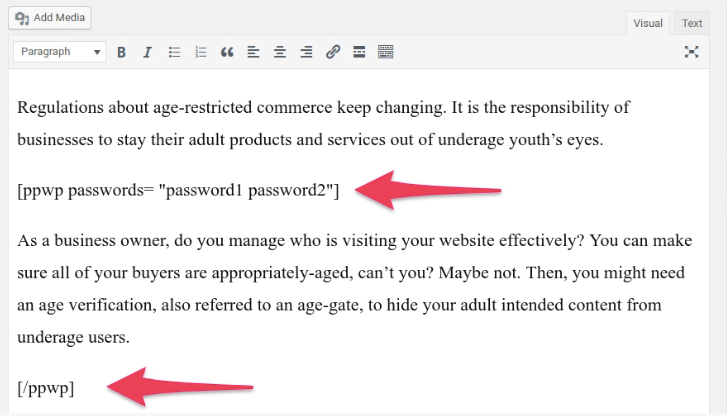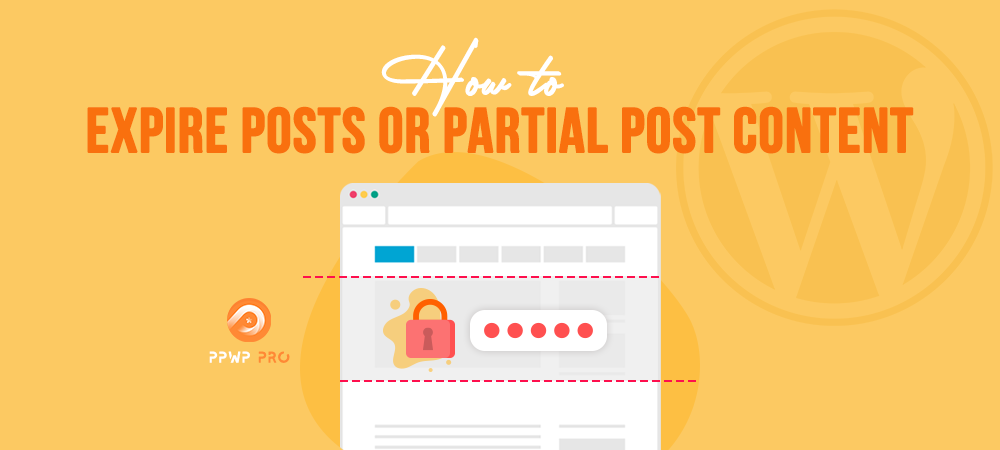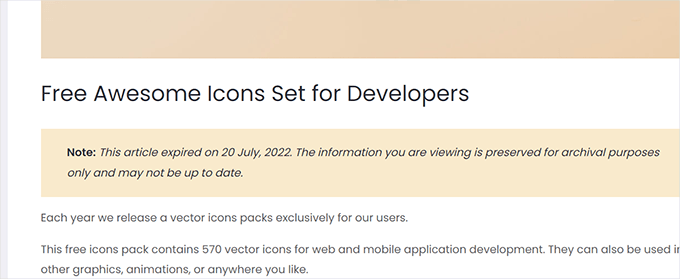Imagine having the ability to make certain content on your WordPress site disappear like magic once it’s no longer relevant. Whether you’re running time-sensitive promotions, seasonal announcements, or just want to keep your website fresh without manual intervention, learning how to expire posts or partial post content in WordPress can be a game-changer for you.
This guide will walk you through the steps to automate your content lifecycle, ensuring your site always delivers up-to-date information that keeps your visitors engaged and eager to return. Are you ready to transform your WordPress site into a dynamic, self-updating platform?
Let’s dive in and discover how you can make your content work smarter, not harder.

Credit: passwordprotectwp.com
Setting Up Expiration Functionality
Expiring posts or parts of posts can improve website management. It ensures content remains fresh and relevant. This feature is useful for time-sensitive content. Offers, events, or seasonal posts can benefit. Setting up expiration functionality in WordPress is straightforward. You can choose plugins or use code. Both methods have their advantages.
Choosing The Right Plugin
Plugins make setting up expirations easier. They offer user-friendly interfaces. You don’t need coding knowledge to use them. The “Post Expirator” plugin is popular. It allows you to set expiration dates and times. The plugin automatically hides or changes content. Look for plugins with good reviews and support. Ensure compatibility with your WordPress version.
Manual Code Implementation
Coding gives more control over expirations. Add snippets to your theme’s functions.php file. This requires basic PHP knowledge. You can set conditions for expiration. For example, hide content after a certain date. Test code in a development environment first. This prevents errors on your live site. Manual coding is flexible but requires caution.

Credit: passwordprotectwp.com
Expiring Full Posts
Learn to set expiry dates for posts in WordPress. Control which content stays or goes. Keep your site fresh by managing post visibility easily.
Expiring full posts in WordPress can simplify content management. It helps maintain a fresh website. This feature removes outdated posts automatically. By setting an expiration date, you keep content relevant. This approach can benefit seasonal promotions or event announcements. Let’s explore two ways to implement this feature.Plugin Configuration
Using a plugin is a simple method. Many plugins offer post expiration features. Install and activate a suitable plugin. Go to the plugin settings. Configure the expiration settings according to your needs. Choose the expiration date and action. Some plugins allow post deletion or draft status. This method is user-friendly. No coding required. Regular updates ensure compatibility with your WordPress version.Custom Code Solutions
For more control, use custom code. This requires basic coding skills. Add a code snippet to your theme’s functions.php file. This snippet sets an expiration date for posts. Customize the code to fit your needs. You can set posts to draft or delete them. This method offers flexibility. Ensure you back up your site before making changes. Test the code in a staging environment. This prevents issues on your live site.Expiring Partial Post Content
Manage WordPress content visibility by setting expiration dates for posts or specific sections. Use plugins to automate this process, ensuring timely updates and relevancy. This feature helps keep your site fresh and engaging.
Expiring partial post content in WordPress offers flexibility. You can control what readers see and when. This feature enhances engagement by presenting fresh information. It also ensures outdated content doesn’t confuse visitors. Let’s explore how to achieve this using shortcodes and conditional content display.Using Shortcodes
Shortcodes make expiring content easy. They allow you to specify dates for content visibility. Start by installing a shortcode plugin. Many are available in the WordPress repository. Once installed, create a shortcode for your post. Specify start and end dates within the code. This controls when the content appears. Shortcodes are a powerful tool. They help manage content efficiently. Readers only see what you want them to see. This keeps your site relevant and engaging.Conditional Content Display
Conditional content display is another method. It uses logic to show or hide content. You set conditions for content visibility. For example, display content only on certain dates. This requires some basic coding knowledge. Use PHP to set these conditions. Alternatively, use plugins that simplify the process. These plugins offer user-friendly interfaces. No coding skills are needed. By setting conditions, you tailor content for specific times. This enhances user experience and keeps content fresh.Managing Expired Content
Easily manage expired content in WordPress by setting expiry dates for posts or specific sections. Utilize plugins to automate this process, ensuring your website stays current and relevant. Keep your audience engaged with up-to-date information, without the hassle of manual updates.
Managing expired content on your WordPress site is crucial for maintaining a fresh and relevant user experience. As your blog grows, older posts or outdated information can clutter your site, leading to a less engaging visitor experience. By efficiently managing expired content, you ensure that your audience always accesses up-to-date information, which can improve your site’s SEO and user retention. Let’s explore practical ways to handle expired content effectively.Redirecting Expired Posts
Redirecting expired posts is a smart way to keep users engaged without encountering dead ends. When a post reaches its expiry, you can set up a 301 redirect to guide users to a newer, more relevant article. This not only enhances user experience but also preserves the SEO value of the original post. Consider using plugins like Redirection or Yoast SEO to automate this process. These tools make it easy to manage redirects without dealing with complex code. Imagine a user landing on an outdated event page and instantly being redirected to an upcoming event—this keeps your audience informed and engaged.Displaying Alternative Content
Instead of letting expired posts go to waste, you can display alternative content to keep the page useful. This could be as simple as suggesting related articles, showcasing a product update, or even offering a downloadable guide. Use WordPress plugins like Content Aware Sidebars or Advanced Custom Fields to customize what appears on expired posts. This approach turns potential dead ends into valuable opportunities for engagement. Picture a scenario where a visitor lands on an expired tutorial, only to find a link to an updated version or a downloadable PDF. This not only retains the visitor’s interest but also reinforces your site’s value. How do you handle expired content on your site? Have you tried redirecting or displaying alternative content before? Your strategies could inspire others looking to enhance their site’s performance.Troubleshooting Common Issues
Learn to expire posts or parts of content in WordPress easily. This guide helps address common issues with plugins or coding. Manage your content’s visibility efficiently.
Expiring posts or partial content in WordPress can be a great way to keep your site fresh and relevant. However, it’s not always smooth sailing. You might encounter a few hiccups along the way. Understanding how to troubleshoot common issues can save you time and frustration. Let’s dive into some of the frequent problems you might face, like plugin conflicts and code errors.Plugin Conflicts
Plugins are like superheroes for WordPress, but sometimes they don’t play nice together. A new plugin meant to expire posts might clash with existing ones. Imagine activating a new plugin only to find your site breaking or slowing down. What can you do? First, deactivate all plugins except the new one. Then, reactivate them one by one to identify the culprit. This method is straightforward and can pinpoint the issue quickly. If you’re still stuck, check for updates or contact plugin support. Have you ever had a plugin conflict that took hours to resolve? Share your experience in the comments; it might help someone else!Code Errors
Adding custom code can be a double-edged sword. It allows for customization but can lead to unexpected errors if not done right. A misplaced semicolon or a missing bracket can break your site. How to troubleshoot? Always back up your site before making changes. Use a staging environment to test your code. It’s like trying out a new recipe before serving it at a dinner party. If an error occurs, review the code line by line. Look for syntax mistakes or incorrect paths. Don’t hesitate to use online forums or communities for help; they can be invaluable resources. Have you ever solved a code error that was driving you nuts? Sharing your tips could be a lifesaver for someone else struggling with similar issues. Troubleshooting can be a daunting task, but with a systematic approach, you can overcome these hurdles. You might discover new techniques or shortcuts that make the process easier. What other issues have you encountered while expiring posts in WordPress? Let’s discuss them below!
Credit: www.wpbeginner.com
Frequently Asked Questions
How To Set Post Expiration In WordPress?
To set post expiration in WordPress, use a plugin like “Post Expirator. ” Install and activate it, then set an expiration date in the post settings. This automatically removes or updates the content as per your configuration.
Can Expired Content Be Restored In WordPress?
Yes, expired content can be restored in WordPress. Navigate to the post in the admin panel and adjust the expiration settings. You can also revert any changes made by the expiration process manually.
Is There A Plugin For Partial Content Expiration?
Yes, plugins like “Content Expiration” allow partial content expiration. Install the plugin and configure the desired content sections to expire. This helps in managing and updating specific parts of your posts effectively.
What Happens When A Post Expires?
When a post expires, it can be hidden, moved to drafts, or updated. The action depends on your expiration settings in the plugin. This helps in keeping your content relevant and timely for your audience.
Conclusion
Managing post expiration in WordPress enhances your content strategy. It’s simple and effective. Setting expiration dates keeps your site fresh and relevant. Readers stay engaged with updated content. Tools like plugins make this process easier. No need for technical expertise.
Just install, configure, and you’re good to go. Regularly review your content plan. Ensure timely updates and removals. This helps maintain your site’s quality and authority. With these steps, your WordPress site remains dynamic. Boosts user experience and SEO rankings.
Start implementing today for a more organized website. Your audience will appreciate the effort.


